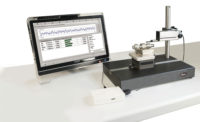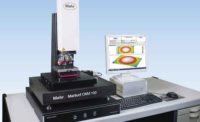Test & Inspection
Assessing Surface Functionality

This combines two high precision measuring systems into one, enabling both roughness and contour measurements to be taken on the same unit and with the same set-up. Source: Mahr

If you needed to apply a coating to a surfaceâas in a car body panel, for exampleâcontrolling the high spot count in your process would help ensure good finish aesthetics. Peak count (RPc) is defined as the number of roughness profile peaks per a unit length that rise above some predetermined line. Source: Mahr

New instruments allow for combined surface and contour measurements. Source: Mahr

A bearing raceway surface is composed of a large number of characteristics or different wavelengths, superimposed on each other. Using harmonic analysis, the amplitudes of these waves are plotted, usually per millimeter, on a histogram chart, as shown here. Source: Mahr




There are many different ways to measure and analyze surfaces.
The science of physics has a whole branch of study—fluid dynamics—devoted to understanding how fluids (liquids and gases) behave upon encountering various surfaces under differing conditions. In the dimensional metrology world, we look at things from the other side, and try to understand how part surfaces behave when encountering their counterparts and fulfilling their various functions.
The traditional view throughout history was that to perform a function, a surface had to be smooth enough, and that if it wasn’t, it either had to be reworked or rejected. Roughness (Ra or Rz) was surface finish and everything else was form. Today we know that all surface geometry—form and finish—are a function of wavelength. Short wavelength characteristics constitute roughness and longer wavelength characteristics contribute to waviness or form. But even wavelength (frequency) is relative to part size. On some micro-sized parts, the typical 0.0030 inch cutoff for a roughness trace may actually be measuring form. On that scale, a roughness reading may reflect a crown or a concavity on the part. So what is form and what is roughness depends on the scale of the parts you’re working with. We have also learned that “smoother” isn’t always better.
Tech Tips
|
Beyond Roughness
A classic case in point involved an automotive manufacturer who was producing a shaft with bearing surfaces specified to an Ra of less than 10 microinches. Things were going fine for a year or so, until a few shafts started seizing up in the bearings. They double-checked the problem shafts, and found the offending parts were all in spec but with Ra values of around eight to 10 microinches. This was close to the limit and previously they had proven the process out with parts that were in the six to eight microinch range of Ra. Thinking that the Ra spec was even more critical than previously thought, they changed the specification to six microinches Ra, and added a costly super-finishing operation to ensure they could meet the spec.
But when they tested prototype parts from this process—all with an Ra of three to four microinches—almost every one of them seized. Finally, a full profile analysis of the parts revealed a longer wavelength error, likely caused by degraded shaft bearings in one of the grinding machines. But waviness had not been specified on the drawings, and all the time and money invested to make the parts smoother had only made them seize more quickly.
Seals and Coatings
Another example that went beyond simple roughness involved an aeronautical application where a rotating engine shaft had to be sealed against oil leakage. The seal had to retain some lubricant to function, of course, but too much lubricant seeping out from under the seal would be noted as a problem during preflight inspection and possibly ground the aircraft. So the problem was perceptual, but serious nonetheless.
But it was also a problem of scale. The company was using the standard 8 millimeter or 0.030 inch cutoff to analyze the surface finish of the shaft to find out how it was interacting with the seal. But the contact area of the seal with the shaft was only about 0.015 inch, so 0.030 as an analysis tool was much bigger than what the seal could “see” when it was in contact with the shaft.
Ideally, the assessment of surface functionality should happen during the design phase, and the requisite parameters and measurement conditions specified on the part prints. A properly given parameter on an engineering drawing should say what parameters are to be measured, what the high or low limits are, and how you measure: what cutoffs to use, or whatever other conditions pertain, such as a cutting depth below the peak.
For example, on a surface designed to be coated, such as a car body panel, controlling high peak count would help ensure good surface aesthetics. The Peak Count (RPc) parameter determines the number of roughness profile peaks per unit length that rise above some predetermined line. On the other hand, if you have two surfaces you need to seal with a gasket, longer spacing is better than short as the gasket will be more readily able to bend and conform. If the peaks are too close together, the gasket material will leave gaps. In this case, mean spacing (Sm) would be a good choice. Furthermore, morphological filters now available in the new ISO 16610 standard provide an excellent means to filter a surface and determine how a gasket will be able to conform to the peaks on a surface.
Lubricants and Loads
But what about more complex functions, such as improving the ability of a surface to retain lubricant or bear loads? These often result from multiple processes or the relationship between those processes. Look at a typical two-part machining process with a rough grind and then a finish grind. The rough grind leaves larger peaks and valleys on the surface, and the finish grind skims off the top, leaving its own, finer marks in place. If you want this part to retain oil, you want to leave a few deep valleys from the first process, but still leave a nice “smooth” surface on the top from the second process.
To do this, you need to be able to control two things about the process: the roughness of the final surface finish, and how deep into the valleys you finish grind or hone. But in the typical manufacturing process, size control and roughness control are separate things. The operator at the finish grinder has a diameter gage and he’s going to keep going until he gets the right diameter. But if the incoming part size varies due to the rough grinding process, his finish grinding is going to affect the ability to retain lubricant as well.
Sometimes the finishing process may remove too much or too little of the high peaks and deep valleys left from the roughing process. In short, trying to hit the right surface finish could mean you get the wrong diameter, while trying to hit the diameter might mean you get the wrong surface.
Measuring parameters, like the Rk family, look at the relationship between these two processes so you can control both effectively.
The ability of a surface to provide a good bearing area is also an important function. It is possible for two surfaces with the same Ra to have very different bearing area properties. The Bearing Area Curve (BAC) and a number of other parameters seek to measure the capability of a surface to support a load. These parameters attempt to quantify the solidity of the bearing surface—that is to say, whether the area in contact between this surface and another will be primarily composed of solid material or just a few roughness peaks.
Harmonic Analysis
Some functionality is even more complex. Consider a ball bearing where the ball has to roll along its raceway as smoothly and efficiently as possible. Any waviness in the raceway—caused by longer wavelength characteristics—will cause the ball to lift or bounce, and any short wavelength, or roughness in the race, will cause unwanted vibration. How do you measure both at once, and how do you determine which particular frequencies are most important?
Bearing manufacturers have developed ways to control virtually all the frequencies on these surfaces using a sophisticated technique called Fourier or harmonic analysis. Most of us probably think of harmonics as relating to sound or music, and in that sense there really are no harmonics involved. The term refers to waves whose frequencies are integer multiples of one another, as are the frequencies of the harmonics on stringed musical instruments. But the idea here is that the bearing raceway surface is composed of a large number of characteristics or different wavelengths, superimposed on each other. In the analysis, the amplitudes of these waves are plotted, usually per millimeter, on a histogram chart.
Typically these charts show the long wavelength, higher amplitude form characteristics on the left, and the shorter wavelength, low amplitude roughness characteristics to the right. But there may be differing sized peaks within that. So what bearing manufacturers do is put a curve on the graph as a limit that no peak is allowed to go above. So the tolerance is not just applied to a single frequency, or a band of frequencies, but to all the frequencies.
This kind of measurement is not really standardized, and every bearing manufacturer has their own best way. But with new systems and software available today, if you can define things mathematically, we can create ways to measure them. But just how bearing manufacturers apply this analysis to their manufacturing process is part of the black art of making bearings.
Cut to the Bone
More sophisticated still are the ways medical device manufacturers are developing to assess the functionality of hip and knee implants to promote bone growth and adhesion. This is still a subject of much research and debate. Some researchers say the key to generating bone adhesion is to develop a surface with lots of porosity. Others say it’s not just the porosity, but the number and sharpness of the nano-sized peaks on the surface that generate spots for bone growth to attach.
Some manufacturers use a coating process for their implants in which material is splattered onto the surface, forming an irregular, spaghetti-like surface with lots of tunnels and overlays. Others do not coat, but polish their surfaces, then acid etch them, so that soft areas are eaten away and the hard areas are left sticking up, so you have a very jagged, rough surface.
No one has yet proven which method works best. In terms of measurement, this is an area where 3-D methods are being applied. An initial 3-D standard was issued recently for areal surface measurement, but so far, there aren’t many revolutionary new 3-D-only parameters in the standard. Current parameters are mostly 3-D analogies for 2-D standards: Sa, or average height over an area, for example, as opposed to Ra, or average height over a linear profile. But the next 15 to 20 years should be very interesting in this regard. In this sense, surface metrology and the assessment of surface functionality are really just getting started.
Looking for a reprint of this article?
From high-res PDFs to custom plaques, order your copy today!








